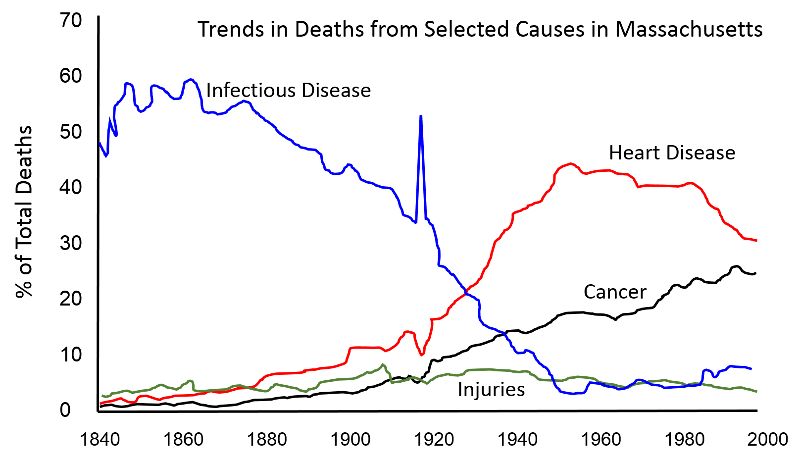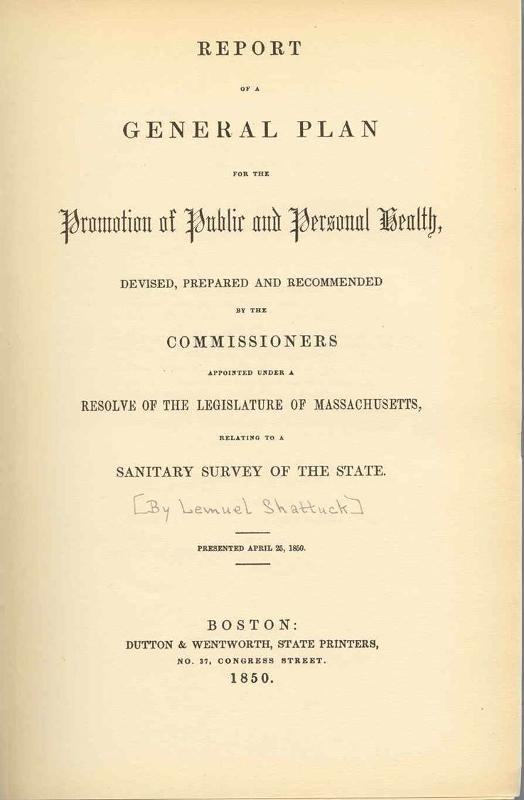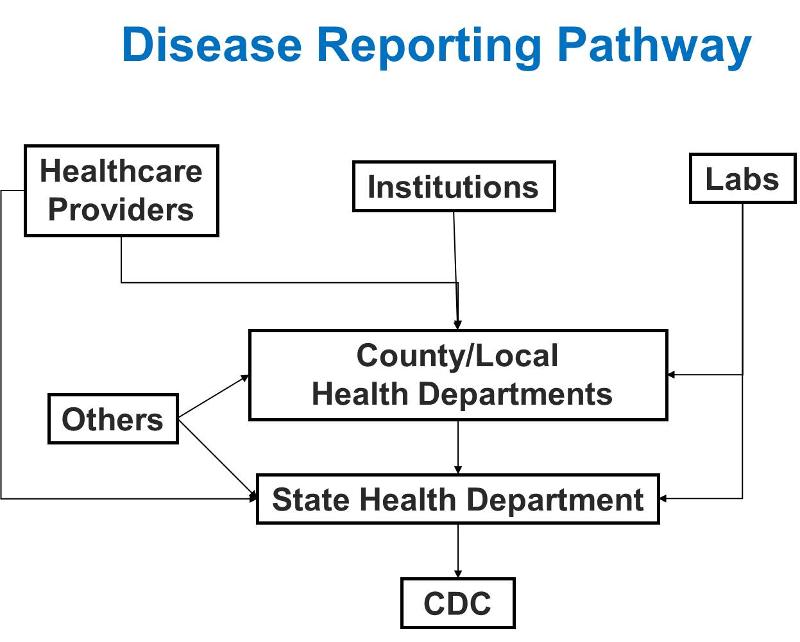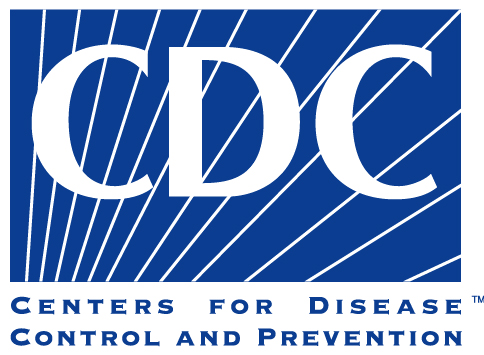
Disease Surveillance & Data Sources
Disease surveillance involves a constellation of information systems that identify and record health related outcomes. Collectively, these systems provide raw data for descriptive epidemiology that is vital for a number of important public health functions, including:

After successfully completing this unit, the student will be able to:

 In order to explore the determinants of disease and health it is necessary to record health related events. In Europe the earliest systematic records regarding births and deaths were recorded in churches. Beginning around 1592 the parish clerks in London began recording deaths. In 1662 John Graunt, a founding member of the Royal Society of London, summarized the data from these "Bills of Mortality" in a publication entitled "Natural and Political Observations Mentioned in a Following Index, and Made Upon the Bills of Mortality." Graunt analyzed the data extensively and made a number of observations regarding common causes of death, higher death rates in men, seasonal variation in death rates, and the fact that some disease had relatively constant death rates, while others varied considerably. In 1837 England established the General Registrar's Office in order to record births, deaths, and marriages in England and Wales. Dr. William Farr was appointed Chief Statistician, and the data that was collected was used by John Snow and by Edwin Chadwick to explore the determinants of disease by looking at how disease rates differed according to factors such as gender, location, occupation, and social class. Measuring disease frequency and making comparisons among groups of people is essential to identifying the determinants of disease and health.
In order to explore the determinants of disease and health it is necessary to record health related events. In Europe the earliest systematic records regarding births and deaths were recorded in churches. Beginning around 1592 the parish clerks in London began recording deaths. In 1662 John Graunt, a founding member of the Royal Society of London, summarized the data from these "Bills of Mortality" in a publication entitled "Natural and Political Observations Mentioned in a Following Index, and Made Upon the Bills of Mortality." Graunt analyzed the data extensively and made a number of observations regarding common causes of death, higher death rates in men, seasonal variation in death rates, and the fact that some disease had relatively constant death rates, while others varied considerably. In 1837 England established the General Registrar's Office in order to record births, deaths, and marriages in England and Wales. Dr. William Farr was appointed Chief Statistician, and the data that was collected was used by John Snow and by Edwin Chadwick to explore the determinants of disease by looking at how disease rates differed according to factors such as gender, location, occupation, and social class. Measuring disease frequency and making comparisons among groups of people is essential to identifying the determinants of disease and health.
Massachusetts played a leading role in the evolution of surveillance and public health in the Americas, beginning with registration of births and deaths in 1842. Lemmuel Shattuck headed the Sanitary Commission of Massachusetts, which submitted its "Report of a General Plan for the Promotion of Public and Personal Health" in 1850. In 1874 Massachusetts established a surveillance system that would be described today as "sentinel surveillance" in which a specified group of 168 physicians submitted regular reports on new cases of 14 diseases deemed "dangerous to the public's health." Ten years later the legislature established a list of "reportable diseases," which all physicians were required to report, subject to fine.
Reporting of infectious diseases evolved more slowly on a federal level. Beginning in 1901, all states were required to report a list of diseases. In 1914 the US Public Health Service began centralized data collection, and in 1925 national disease reporting became mandatory. Since then, surveillance has evolved to include not just a handful of infectious diseases, but a host of infectious and non-infectious disease and conditions and behaviors. The CDC now defines surveillance as "the ongoing systematic collection, analysis, and interpretation of health data essential to the planning, implementation, and evaluation of public health practice, closely integrated with the timely dissemination of these data to those who need to know."
In order for surveillance to have a meaningful impact on planning, implementation, and evaluation of public health practice, the data collected from the surveillance system must be organized and analyzed in a thoughtful, structured way, and the results must be communicated in a clear, effective way to both the public health workforce and the community at large.
Epidemiology is the study of the distribution and determinants of disease frequency in human populations. It is critically important to have records that document the occurrence of disease events and the presence of possible determinants of disease. Today there are many sources of data that are useful for monitoring the health of populations and for exploring how disease frequency changes over time, and how it relates to personal characteristics and location (person, place and time). Below is a partial list of examples of possible data sources.

And there are many cross-sectional surveys and databases that are periodically conducted, many of which can be accessed from the National Center for Health Statistics.
Here is a list of links to some of these resources:
Link to US Census
Link to US National Vital Statistics System
Link to Massachusetts Registry of Vital Statistics and Records
Link to Massachusetts Vital Statistics Directory
Link to Massachusetts Cancer Registry
Link to ALS registry (amyotrophic lateral sclerosis, or Lou Gehrig's disease)
Link to Parkinson's disease registry
Link to Massachusetts Health Data Consortium (a registry of hospital discharge summaries in Massachusetts)
Link to MassCHIP) In the state of Massachusetts the Community Health Information Profile [MassCHIP] provides a dynamic, user-friendly information service for obtaining free, online access to many health and social indicators. With MassCHIP, you can obtain community-level data to assess health needs, monitor health status indicators, and evaluate health programs.
Link to US National Center for Health Statistics,
Link to US National Survey of Family Growth
Link to US National Survey of Early Childhood Health
Link to US National Health Interview Survey (NHIS)
Link to US National Health & Nutrition Examination Survey (NHANES)
Link to Behavioral Risk Factor Surveillance System (BFRSS)
Link to US National Death Index
The short video below provides an excellent overview of public health surveillance.


Professor Richard Clapp from the Environmental Health Department at Boston University School of Public Health was instrumental in the founding of the Massachusetts Cancer Registry. One of the events that helped provided momentum for the establishment of the MA Cancer Registry was a cluster of leukemia cases that occurred in Woburn, MA in association with environmental contamination. Dr. Clapp was involved in the environmental investigation and became friends with Jan Schlichtmann, the lawyer for the families of the victims. This cluster of leukemia cases and the prolonged legal battle became the subject of a best-selling book ("A Civil Action") by Jonathon Harr, and later it was made into a motion picture starring John Travolta. In the short video clip shown here, Dr. Clapp talks about the founding of the Cancer Registry.
Here are links to two articles from the UNC Focus series; they provide an overview of public health surveillance:
A CDC online course, Environmental Public Health Tracking 101, provides an overview of the major components of environmental public health tracking. The course is divided into 12 modules within three sections. Topics include how to use the National Environmental Public Health Tracking Network (Link to http://www.cdc.gov/ephtracking), surveillance and epidemiology, types of tracking data, and geographic information systems.
The online course is available at Link to http://www.nehacert.org. The course can be accessed by entering "Tracking 101" in the search box. Continuing education credit is available at no charge for nurses, health educators, and other health professionals.
Notifiable Diseases: Each US state designates a specified list of "notifiable diseases," i.e., diseases that health care providers and/or laboratories and hospitals are required to report to the state.
In Massachusetts, local boards of health, healthcare providers, laboratories and other public health personnel must report certain "notifiable diseases" as required by law (Massachusetts General Laws, Chapter 111, sections 3, 6, 7, 109, 110, 111 and 112 and Chapter 111D, Section 6. These laws are implemented by regulation under Chapter 105, Code of Massachusetts Regulations (CMR), Section 300.000: Reportable Diseases, Surveillance, and Isolation & Quarantine Requirements.) The Massachusetts Department of Public Health provides a Reportable Diseases web site as an on-line resource for local health departments, clinical providers, hospitals, laboratories and others.
Here are links to these documents and sources:
Link to Massachusetts General Laws, Chapter 111, sections 3, 6, 7, 109, 110, 111 and 112 and Chapter 111D, Section 6.
Link to Chapter 105, Code of Massachusetts Regulations (CMR),
Link to Section 300.000: Reportable Diseases, Surveillance, and Isolation & Quarantine Requirements.
Link to Reportable Diseases web site
Link to list of reportable diseases in Massachusetts

Passive Surveillance: While reporting is required by law, there is no practical way of enforcing adherence, so disease frequency is under reported. Nevertheless, this system has proven to be useful in identifying outbreaks and trends over time. Health care providers report notifiable diseases on a case-by-case basis. Passive surveillance is advantageous because it occurs continuously, and it requires few resources. However, it is impossible to ensure compliance by health care providers; moreover, cases occurring in people without access to care will frequently go unreported. Consequently, passive systems tend to under-report disease frequency.
Active Surveillance occurs when a health department is proactive and contacts health care providers or laboratories requesting information about diseases. While this method is more costly and labor intensive, it tends to provide a more complete estimate of disease frequency.

The Massachusetts Virtual Epidemiologic Network (MAVEN) is a web-based disease surveillance and case management system that enables MDPH and local health departments to capture and transfer appropriate public health, laboratory, and clinical data efficiently and securely over the Internet in real-time.


 Data for selected nationally notifiable diseases reported by the 50 states, New York City, the District of Columbia, and the U.S. territories are collated and published weekly in the Morbidity and Mortality Weekly Report (MMWR). Provision data is available online making it possible to easily look up weekly counts of reportable infectious diseases for the entire US. There are both Morbidity Tables and Mortality Tables.
Data for selected nationally notifiable diseases reported by the 50 states, New York City, the District of Columbia, and the U.S. territories are collated and published weekly in the Morbidity and Mortality Weekly Report (MMWR). Provision data is available online making it possible to easily look up weekly counts of reportable infectious diseases for the entire US. There are both Morbidity Tables and Mortality Tables.
Link to the Morbidity and Mortality Weekly Report (MMWR)
Link to Morbidity Tables
Link to Mortality Tables
|
From the DEISS web site: "The Epidemiology and Laboratory Capacity for Infectious Diseases Cooperative Agreement (ELC) was formed in 1995 as a key component of CDC's national strategy to address emerging infectious disease threats. The program plays a critical role in strengthening national infectious disease infrastructure by providing funding to all 50 state health departments, 6 local health departments (Los Angeles County, Philadelphia, New York City, Chicago, Houston, and the District of Columbia), Puerto Rico, and the Republic of Palau to prevent, detect, and respond to new and emerging infectious diseases. With ELC support, health departments build their public health capacity by hiring and training staff, buying laboratory equipment and supplies for diagnosing emerging pathogens, and investing in information technology to improve disease reporting and monitoring. ELC investments support work on zoonotic and vector-borne diseases (particularly rabies and West Nile Virus [WNV]), foodborne diseases, influenza, antimicrobial resistance, and prion disease. The ELC has also provided health departments with the flexibility and capacity to quickly recognize and respond to outbreaks of new and emerging infectious disease threats, such as SARS and monkeypox."
|
Link to the Division of Emerging Infections and Surveillance Services (DEISS)
As an example of the utility of this overall surveillance system consider the many outbreaks of foodborne infectious disease that have occurred in the US over the past few years. In essence, each individual case of foodborne illness was reported to a local health department, and the information flowed to the state level and then to the National Notifiable Disease Surveillance System (NNDSS). The data in the NNDSS then made it possible to conduct a systematic review of changes in foodborne disease frequency over time, as reported in the publication by Scallan et al in Emerging Infectious Disease (see below).
Trends in Foodborne Illness in the United States
Foodborne Illness Acquired in the United States - Major Pathogens: Elaine Scallan, Robert M. Hoekstra, Frederick J. Angulo, Robert V. Tauxe, Marc-Alain Widdowson, Sharon L. Roy, Jeffery L. Jones, and Patricia M. Griffin, Emerging Infectious Diseases 2011;17(1):7-15. [Volume 17, Number 1, January 2011, pages 7-15]
Below there is a link to an audio pod cast of a brief interview with Dr. Scallan, the lead author of the article, in which she discusses the most recent estimates of illnesses due to eating contaminated food in the United States. Dr. Scallan is an Assistant Professor at the University of Colorado and former lead of the CDCs FoodNet surveillance system. (Running Time = 8:48)

Link to complete article in PDF.
Syndromic surveillance is a relatively new surveillance method that utilizes clinical signs and symptoms that have been recorded for patients in medical treatment facilities. The premise of syndromic surveillance is that the first sign of serious acute illness in a community might be an unusual number of people seeking care for non-specific symptoms/signs. A "syndrome" is a cluster of signs and symptoms. For example, influenza is characterized by the sudden onset of fever, shivering, chills, dry (non-productive) cough, general malaise, body aches, and sometimes nausea. These symptoms could be caused by influenza or by any number of other upper respiratory tract infections, including the common cold, although flu symptoms tend to be more severe. Nevertheless, some combination of these symptoms might be defined as indicating a "flu-like illness" and the frequency of this syndrome has been found to correlate with the frequency of documented influenza. The use of syndromic surveillance is attractive because of the possibility that automated surveillance systems might be created, e.g., as described by Marsden-Haug et al. For additional information on syndromic surveillance, see the CDC web page: CDC: Syndromic Surveillance: an Applied Approach to Outbreak Detection.
Link to Marsden-Haug et al.
Link to CDC: Syndromic Surveillance: an Applied Approach to Outbreak Detection
Link to MMWR article on Health Department Use of Social Media to Identify Foodborne Illness — Chicago, Illinois, 2013–2014link to an article about the possible use of "Yelp" to track foodborne illness.
Link to an article on the possible use of "Yelp" to track foodborne illness.


 .
.